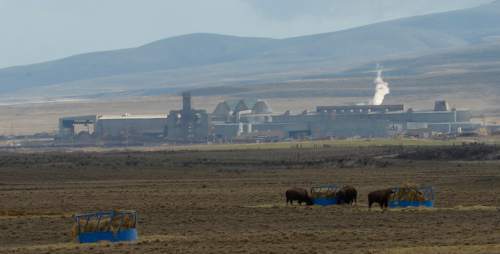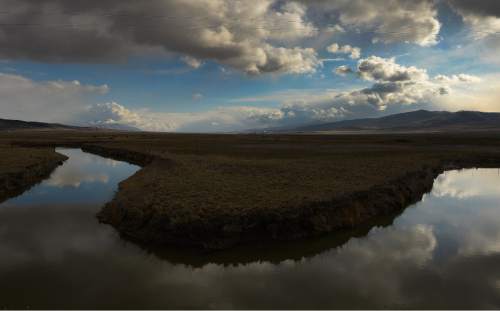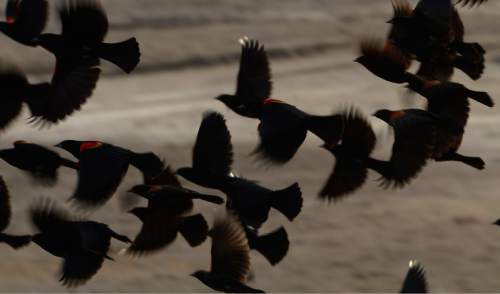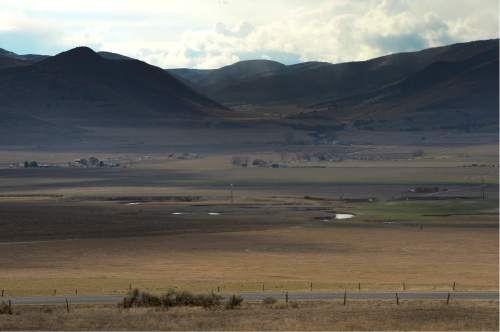This is an archived article that was published on sltrib.com in 2015, and information in the article may be outdated. It is provided only for personal research purposes and may not be reprinted.
There are few new sources of water for the thirsty Wasatch Front.
Canyon streams have been piped. Groundwater has been tapped. Irrigation canals meander the Salt Lake Valley from Utah Lake in the south to the salt-laden sea in the north.
So state water managers are looking north to one of the last unmanipulated waterways in Utah — the Bear River — for the future.
It's not the first time the Bear has been considered the salvation of the state's burgeoning, Kentucky-bluegrass-loving population. Since the 1960s, the river that winds from the Uintas, through Wyoming and Idaho and back into Box Elder County has been a water backup plan.
But the latest scheme for taming the Bear, released last July, is gaining momentum. The massive, $1.5 billion project calls for damming the river in multiple locations to "store" 220,000 acre feet of water that eventually will flow through a 50-mile pipeline to be sprinkled on lawns from Ogden to the Oquirrh Mountains. Construction would start in 10 years.
A bill making its way through the Utah Legislature would pair the Bear River project with the proposed Lake Powell Pipeline, setting up a slush fund to stockpile cash for both.
Water agency managers say even that slush fund probably won't be enough. They estimate it will cost $32 billion to meet new water demand and maintain current sources through 2060.
In the Jordan Valley Water Conservancy District's west Salt Lake County area alone, demand is projected to nearly double in the next 45 years.
"Where does that new water supply come from?" asks district director Richard Bay.
Conservationists, on the other hand, say Utah is too quick to build. The two projects are unnecessary and are based on faulty estimates of the state's true water needs. Water managers should focus first on encouraging Utahns to use less water, they say, before committing residents to expensive, environmentally damaging projects.
"We could build these reservoirs and pipelines and welcome the huge construction costs and expensive lawsuits that will surely follow," says Dan McCool, a University of Utah political science professor who focuses on water resources. "Or, we could just change the way we use water. That really is the choice we are facing."
That choice pits water agencies and even rank-and-file homeowners against environmental groups in the ongoing debate over the Bear.
—
During his State of the State address two years ago, Gov. Gary Herbert urged Utahns to reduce their water use by 25 percent per capita by 2050. Homeowners responded and have already achieved about an 18 percent reduction, which allowed the governor to bump the deadline up to 2025.
McCool, who also authored "River Republic: The Fall and Rise of America's Rivers," is not impressed. He appreciates the existing conservation efforts, but for him, and other water watchers, much more can be done.
"Denver just saved 40,000 acre feet of water primarily by changing toilets in public schools and subsidizing people to change the toilets in their homes," McCool says. "We could dry up the Great Salt Lake or change our toilets. Which one do you want to do?"
Utah is the second-driest state in the country, but no other state uses more water per person per day. For awhile, Utahns used less water than their neighbors in dust-dry Nevada, but no more. A United States Geological Survey released last fall showed the average Utahn used 248 gallons every day between 2005 and 2010 — higher than residents of Nevada and Arizona and California.
That leaves plenty of room for conservation according to Zach Frankel, executive director of the Utah Rivers Council. He blames Utah's low water prices for discouraging conservation.
"It is a myth that we are running out of water," says Frankel. "We aren't using what we have efficiently and we are then translating that high number into a model for future use. They are using selective data to inflate numbers."
Senate Majority Whip Stuart Adams is pressing his colleagues to link the Bear River Project with the controversial Lake Powell Pipeline, a 140-mile water delivery system for St. George. His legislation, SB281, would create a state account to collect funding for both projects. The Layton Republican hopes to set aside money during the 2015 session to prepare Utah's "undeveloped share of the Bear and Colorado rivers."
Adams argues the water slush fund is necessary to accommodate the state's inevitable population growth. "The only limiting factor to growth is water," he said at a legislative hearing last week.
But water watchdogs say Adams' approach to water management is backward.
Frankel, McCool and Bay all serve on the state Water Strategy Advisory Team along with federal officials, state lawmakers, climatologists and industry representatives. McCool said discussions at the meetings have focused on conservation with mixed results.
The team talked about pushing the governor's goal of a 25 percent reduction in water use to 35 and even 50 percent. Most of the change would require cutting into outdoor landscaping.
To reach the 35 percent mark, Bay says, homeowners, businesses and governments would have to limit the amount of "green" on a property to 30 percent of the area. The rest would be "hardscaping" like bark mulch or rocks. A 50 percent reduction would "mean just 10 percent of the total community outdoor area" could be lawn.
"That's going beyond Albuquerque. That is blowing tumbleweed, buffalo skulls and rattlesnakes," he told the group. "We are not being realistic if we think our public is going to accept that."
Bay says there are other ways to promote water conservation. Water demand for Jordan Valley Water Conservancy District, one of the biggest water districts in the state serving roughly 620,000 residents in southwestern Salt Lake County, is expected to balloon 371,000 acre feet to 760,000 acre feet by 2060.
Next year, district managers plan to test water-metering systems that will allow users to view their up-to-the-minute consumption of water, rather than waiting more than a month to get a bill.
"People are accustomed to having information instantly now," Bay says. "This gives them a chance to practice water conservation through monitoring rather than guessing.
"People have told us they want to know how they compare to their neighbors and how they compare to those who are efficient. We expect this will help save water."
—
In the meantime, water managers are starting to prepare to divert the Bear.
The Jordan Valley and Weber Basin conservancy districts already jointly purchased property for a transfer station in West Haven and have been acquiring land along the proposed pipeline corridor.
"We would not have been able to stay ahead of the land development if we had not been buying right-of-way over the last 20 years," Bay says. "If we had waited, we would have been buying 42 miles of houses."
Even so, the project is expensive.
One proposed reservoir site Utah lawmakers insisted be included just south of the Idaho border, would require channeling the Malad River around a dam on the Bear. Pricetag for "Washakie": $109 million.
The Malad River, which eventually dumps into the Bear, would not be included in Utah's water project. The water quality is not suitable, says Marisa Egbert, an engineer with the Utah Division of Water Resources.
Originally, the 600-page plan identified 45 potential reservoir sites throughout northern Utah, but those have been winnowed down to seven, Egbert says. The Washakie proposal is likely too expensive and won't make the cut, she adds.
Whatever the final cost estimate, McCool believes the project will end up costing much more than expected.
"As a general rule, when it comes to Western water projects, they end up costing twice as much as they say the will," McCool said. "It could easily end up being $4 billion and creating a tremendous burden on our society."
But water district managers say the cost of not building the massive water-delivery system is much more. Without a $14 billion investment in water projects over the next 45 years, according to a "Prepare60" report from the state's four largest water agencies, 930,000 jobs, $93 billion in economic activity and $71 billion in new incomes would be at risk.
"The general answer if we don't find new ways to get water is that we would reach a point we couldn't grow anymore and we would be sending our children and grandchildren away because we can't accommodate their basic needs anymore," Bay says. "There is a cost we would incur for not doing it."
If the project moves forward, the Bear's water is not projected to be used until 2035.
brettp@sltrib.com Twitter: @BrettPrettyman











